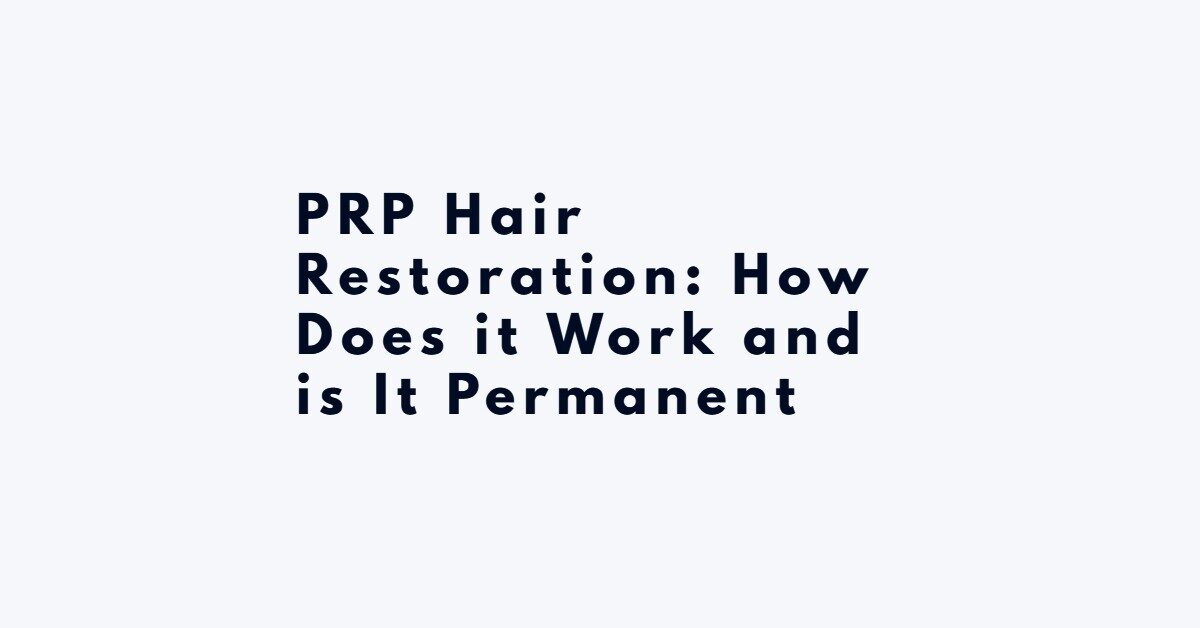Hair loss can be treated easily with a treatment called PRP hair restoration therapy. This is one of the best procedures to restore your hair. Read on to understand better how PRP is done and what makes it the best in hair loss treatment.
The hair restoration medical profession has come a long way, and techniques used to help hair loss patients to restore hair are always changing for the better. Nowadays, patients are going for hair loss treatments that offer a more natural look and permanence. These types of hair loss treatment solutions are available in many hair restoration clinics in Los Angeles and around the world. Some of the best and latest hair loss treatments include hair transplant, scalp micro-pigmentation, and PRP hair restoration therapy.
Today, we are focusing on PRP hair restoration treatment to see what it offers hair loss patients and whether permanence is one of them. This will help you to understand the treatment better and whether it is an ideal hair loss treatment for you. Read along for more insights.
What does PRP Stand for?
Before opting for any kind of hair loss treatment, you need to understand the technique and how it works in restoring your hair. You need to know whether you are the candidate for the procedure and where there are risks and side effects involved in the treatment. Let’s first define PRP and later move on to how the procedure is done and whether it is worth the hype.
PRP, in full, means platelet-rich plasma. Plasma is a blood component in our bodies that contains high concentrations of platelets. Blood is made up of many components, including red blood, white blood cells, and plasma. The red blood cells are used to carry oxygen from the lungs to other parts of the body. The white blood cells contain antibodies, which are used to fight pathogens and other harmful germs in our bodies.
Plasma, on the other hand, contains tiny cells called platelets, which allow the body to recover quickly when body tissues are injured or when they have died.
PRP Treatment for Body Injuries
Contrary to what many people know, PRP is not a foreign concept. It was discovered and implemented about 50 years ago. When it was discovered, it was and is still used to treat patients who suffer from tendon, muscles, and ligament injuries.
PRP Hair Restoration Treatment
PRP hair restoration is done by an authentic surgeon in the office or clinic. The treatment only takes a few hours to complete. The therapy requires the patient’s blood. Therefore, the first thing that the doctor will do is to draw out blood from the patient. Only a small sample of about 30 ml is needed for the treatment. After that, platelet-rich plasma needs to be extracted from that sample.
The extraction process involves putting the blood sample into the centrifuge machine and spinning it rapidly for about 10 minutes. The spinning process is meant to divide the blood into three levels containing three components:
- Red blood cells
- Platelet-rich plasma
- Platelet-poor plasma
The doctor is only after the platelet-rich plasma; therefore, he is going to draw it using a syringe. The PRP solution is then mixed with other chemicals to make it more effective. It is then drawn back to the syringe and injected into the patient’s scalp that is suffering from hair loss or thinning hair.
Sometimes the patient may not have enough platelet count in the blood. In this case, he or she will be placed under platelet enhancement medication for about two weeks. When the two weeks end, the doctor proceeds with the treatment.
Platelets are very small cells in the blood responsible for blood clotting when tissue damage occurs. When blood clots, it prevents the body from bleeding. Another function of platelets in our bodies is to repair injured tissues. PRP contains growth factors that help to generate new cells and rejuvenate weak tissues. When treating hair loss, PRP solution is injected into the patient’s scalp to rejuvenate dormant hair follicles.
Hair Transplant Fusion with PRP
To enhance and make the hair transplant more effective, the procedure is combined with PRP. During the FUT or FUE hair transplant, the harvested hair follicles are placed into the PRP solution before being transplanted. This is meant to increase the survival rate, rejuvenate and stimulate the hair follicles before being transplanted.
The doctor will also inject the patient’s recipient area with PRP after the surgery to speed up healing and ensure that the grafted hair takes. This technique was just introduced recently and is called the smart FUE hair transplant. After the transplant procedure, the patient will heal very fast, and at the same time, the new hair will be strong, permanent, and more natural.
Conclusion
Advancements made in the hair restoration medical field have made it possible for hair loss patients to grow new hair fast and more naturally. The PRP hair restoration therapy is a regenerative treatment that is meant to stimulate and activate dormant hair follicles to grow strong and dense hair in thinning hair regions. When combined with the FUE hair transplant, patients with extensive hair loss conditions will enjoy strong and dense hair permanently.


